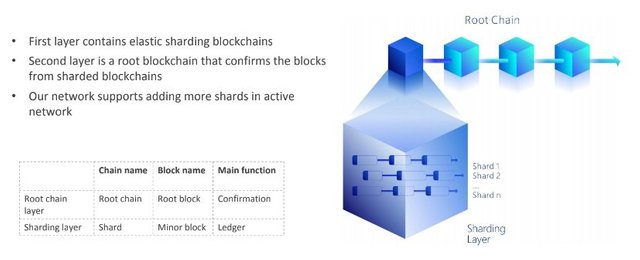QuarkChain review - Highly Scalable Secure Blockchain
QuarkChain is aiming to build a multi-layer, peer-to-peer transaction blockchain. The first layer of system contains shards ( which allows for high throughput by effectively distributing data ), while the second layer is comprised of a root chain ( which serves to confirm the blocks of the first ). The architecture of QuarkChain is predicated on finding a balance between security, scalability and decentralization.
Tackling the big three problems: Decentralization, Scalabiliy and Security
Scalability and security do not go always hand-in-hand when it comes to blockchain technology. QuarkChain have set out to find a solution that balances both these needs. QuarkChain allows for two types of transactions- in-shard and cross-shard. In-shard transactions occur between addresses on the same shard. However, setting the QuarkChain apart from other high-throughput solutions is the ability to conduct cross-shard transactions. The throughput of the cross-shard transactions system will scale linearly as the number of shards increases.

By introducing the “Collaborative Mining” system, miners are encouraged to mine in accordance to their own selfish tendencies. The difference here is that the system is designed such that when everyone decides to act selfishly in their best interest, it collectively supports the entire network because they are putting in the best effort.
It has been designed specifically so that miners are able to select and mine directly to any of the sharded blockchains. This means they do not have a good reason to join mining pools and end up creating a powerful centralized team of miners. It makes more sense to go solo on this.
In order to launch a hash attack against Quarkchain, a total of 25% computing power is needed to start manipulating the blocks. If miners somehow got together and combine their computing power, the entire network is in trouble. However, if we refer to the above example on decentralization, miners do not have any incentive to combine forces because they can already do it themselves. It would require a lot of propaganda and group incentives to entice miners to team up for a special attack.
How far along is QuarkChain?
The project is still under development, though they secured ~2,000 transactions per second (TPS) on their early closed test. Recently a test was made and can be found in this youtube review:
This is the projected roadmap for the project:
Q2 2018 - TestNet 0.2 release which will support most of QuarkChain’s features such as smart contract, reshard, and so on.
Q4 2018 - QuarkChain Core 1.0 release, Mainnet 1.0, and Smart Wallet (aiming for ~100,000 TPS at this time).
Q2 2019 - QuarkChain Core 2.0 release, Smart Wallet 2.0, (aiming for ~1 million TPS with clustering at this time).
Resources :
White paper: (English) https://quarkchain.io/QUARK%20CHAIN%20Public%20Version%200.3.4.pdf
https://cryptobriefing.com/quarkchain-ico-review-qkc-token/
https://cryptobriefing.com/quarkchain-code-review-deep-dive/